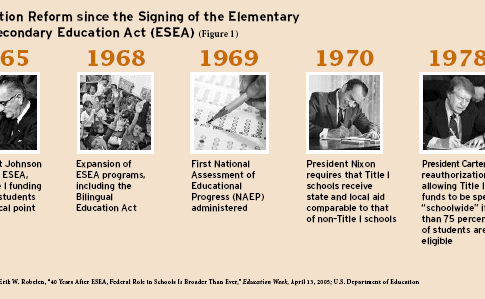 No Child Left Behind (NCLB) may be the most vilified act of Congress in modern times. Just about anybody can find something in the law to get worked up over: the testing rules, “highly qualified teachers,” funding shortfalls and so on. It’s great fodder for presidential candidates, too, one of whom recently went so far as to blame the childhood obesity problem on NCLB and to equate companies providing tutoring to low-income students to Halliburton. Funny thing is NCLB is actually doing some good things for real people, many of them students who historically have been shortchanged in our public schools.
No Child Left Behind (NCLB) may be the most vilified act of Congress in modern times. Just about anybody can find something in the law to get worked up over: the testing rules, “highly qualified teachers,” funding shortfalls and so on. It’s great fodder for presidential candidates, too, one of whom recently went so far as to blame the childhood obesity problem on NCLB and to equate companies providing tutoring to low-income students to Halliburton. Funny thing is NCLB is actually doing some good things for real people, many of them students who historically have been shortchanged in our public schools.
I was an early, proud supporter of the law, and I still am. My civil rights colleagues and I fought for some of its tougher provisions, like accountability for subgroups of students, the 2014 proficiency deadline, requiring states to submit plans for the equitable assignment of teachers, and providing a way out for kids trapped in failing schools. By now, most of the criticism of NCLB—some legitimate but some ginned up by special interests opposed to real accountability—seems pretty old and tiresome.
Let’s examine some of the grenades most commonly lobbed at NCLB.First, there is the oft-heard complaint that the measurement system for accountability is all wrong. Why? Because NCLB doesn’t call for measuring students’ growth from year to year. Instead, the measurement system in the law compares the proficiency levels of this year’s 3rd graders to last year’s 3rd graders. This is also called the “status model.”
Suggesting that NCLB 1.0 is flawed because it did not explicitly provide, back in 2001, for “growth models” is like saying my 2001 desktop was a bad buy because in 2007 it can’t run Windows Vista or streaming video. Virtually none of the states had the technology and other capacity to design and implement growth-measurement systems in the early years of this authorization. The fact that Education Secretary Margaret Spellings has approved only seven to date is not because she’s not eager to see many states move in this direction. There simply aren’t, even today, many states ready, willing, and able to carry out a credible, statistically sound growth-based accountability system.
Since 1994 the “status model” has been the accountability paradigm embedded in Title I, and in many state accountability systems as well. It was based, in part, on public health models that aspire, for example, to increase numbers of annual healthy births and immunized kindergarteners and decrease things like malnutrition, disease, and teen pregnancy. Significantly, it was not until sometime after NCLB’s final passage that the noise level about the “status” model and the plea for growth measures became audible. And this was not because states suddenly had vast new capacity to measure growth. They didn’t. Instead, increasingly, leaders of the education establishment (i.e., school boards, administrators, and the teacher unions) were doing their Adequate Yearly Progress (AYP) math in the context of the 2014 deadline. They rightly feared that, unlike the Clinton administration, the Bush administration was determined to enforce the law, particularly with regard to assessment and accountability. Simply put, they hoped that with a growth model, they might get credit for some amount of improvement in test scores, even if the requisite numbers of students were not actually proficient.
This political background is important context for the debate taking place in Congress. Virtually nobody disputes the merits of allowing states to base their accountability systems on the value a school or teacher adds to a student’s knowledge and skills. But when it comes time for Congress to get down to actual legislative language, members will have to choose whether to open the door to all comers, including states with pitifully low standards (compared to those of the National Assessment of Educational Progress), deficient data and student-tracking systems, and a poor track record on including English language learners and students with disabilities. Or they can take the more prudent course, accede to the secretary’s good judgment, and limit the “growth” option to those states that can demonstrate both the capacity and the rigor required to bring students to proficiency within a specified period. Thus, simply arguing “growth measures good, current law bad” may in the end not be very helpful to the deliberations on Capitol Hill and could well undermine the efforts of those who favor only those growth systems that can meet tough standards for rigor, reliability, and inclusion of all students.
Then there’s the suggestion that the 2014 proficiency deadline is crazy. Says who? Certainly not the parents whose children attend persistently low-performing schools and for whom even one school year is too much time to lose.
Increasingly we are seeing high-poverty, high-minority schools across the country that are achieving outstanding academic success. In high-achieving schools, proficiency for all students is possible this year. Let’s do what we can with NCLB to drive the dollars and incentives to the schools that are replicating the no-excuses approach to teaching the children of the poor.
Common Ground?
Perhaps surprisingly, my fellow forum authors and I agree on the importance of NCLB’s core aspirations:
• Transparency and public reporting of student achievement data
• The need for high standards pegged to postsecondary education and careers
• Regular assessment in reading and math
• Accountability based on assessment results
• Options for parents.
We even agree on some of the more nuanced, yet potentially powerful, improvements Congress and states could enact to strengthen education reform:
• Differentiated consequences
• Continued efforts to measure growth from year to year
• Measuring effectiveness and attaching rewards/consequences for administrators and teachers.
Finally, we may actually agree on the most radical proposal from the standpoint of the more than 40-year history of the Elementary and Secondary Education Act (ESEA): Congress should not continue to subsidize failure after providing years of assistance and the opportunity to improve. There are a variety of ways to remove funding from chronically low-performing schools and transfer it to better schools (including moving the dollars in the figurative “backpacks” of the students) that merit serious consideration.
Our disagreements reflect our fundamentally different beliefs about the role of the federal government itself, particularly with respect to advancing the interests of the poor and minorities. Since when has leaving it all up to the states helped the poor and minorities achieve equality of opportunity? Not when it came to voting rules. Not when it came to public accommodations. Not when it came to desegregating schools in the aftermath of Brown v. Board of Education. And certainly not now, when the achievement gaps based on race and class are as virulent as ever, with only modest signs of abatement.
Of course, not everything is working perfectly yet. School choice and supplemental educational services were not high on the political priority list under the first Bush administration, but it does not follow that these two vital provisions for parents cannot be made to work. It often takes a period of years (sometimes even a complete authorization cycle) for a controversial new provision to take root. For example, most states did not pay much attention to the “accountability lite” provisions in the Clinton-era Improving America’s Schools Act (IASA), nor did that administration do much to signal to states that it would enforce IASA’s requirements for “corrective action” and school improvement. It took another authorization and a clear signal from the Bush administration that the federal government was serious about accountability in order for the states to come up with plans to hold their own schools and districts accountable.
Moreover, there are encouraging signs of bipartisan support for proposals to add some real teeth to the public school transfer options in NCLB. Currently, parents may choose a better school when their child’s school fails to make AYP, but as the Lawyers’ Committee for Civil Rights Under Law has called it, the choice option is “a right without a remedy.” School districts implement the provision only halfheartedly and many argue a lack of space in successful schools. The interdistrict provisions in the law are weak, and charter options are not meaningful in states with arbitrary limits on new charter schools.
The Citizens’ Commission on Civil Rights, along with the Aspen Institute’s NCLB Commission and other proponents, have proposed tough new measures to guarantee public school choice to children who attend persistently low-performing schools. One proposal would deny states that do not provide parents and children with demonstrably better choices their Title I money. States would have the obligation to create and offer those children in the worst schools seats in better-performing schools. To increase seats, states could lift caps on the number of charter schools, expand successful schools, or provide for interdistrict transfers. A second proposal would require an “audit” to determine whether capacity in better schools actually exists and, if so, where. Finally, the Aspen Institute and a number of civil rights organizations favor enabling parents to take legal action when rights conferred under NCLB, like the right to place their child in a better-performing school, are violated. Congress should consider how best to target funding to the schools, leaders, and models that have the best record of success in high-poverty communities. But the bottom line is that unless and until the money is used to leverage dramatic change, there is unlikely to be any marked change. And without dramatic change, achievement gaps are unlikely to close any time soon. The status quo is a powerful player to be reckoned with in the struggle for educational equity.
The Pace of Reform
NCLB is in many respects the latest in a long line of efforts in the policy and legal arenas to promote equity and opportunity in the public schools, including desegregation cases, the Civil Rights Act of 1964, the original ESEA, and school finance and adequacy cases in the states.
How long does it take a cutting-edge civil rights law to “work”? Could a credible argument have been made in 1969, five years after passage of the Civil Rights Act, that the ambitious law was “not working” and therefore ought to be abandoned?
This particular legislation needs to be strengthened by ensuring high state standards, reliable assessments, realistic school-improvement measures, an equitable distribution of effective teachers, and real parental choice. Those of us—on the left, right, and middle—who believe in the transformative power of education need to draw more from the work of the increasing numbers of urban schools that are demonstrating how to succeed with large numbers of poor and minority students despite the odds. We need to learn from the contagious successes of outstanding public schools and choice programs like the Amistad Academy in Connecticut, the Green Dot schools in California, and the voluntary interdistrict transfer program in St. Louis.
Abandoning NCLB now would be the height of cynicism. Instead, like the civil rights movement itself, the education reform movement is in dire need of creative thinking, committed education leaders, and informed, involved parents—all united in our belief in the worth and value of every young life and each child’s potential to learn and do great things.
Dianne Piché is a civil rights lawyer, teacher, and advocate and serves as executive director of the Citizens’ Commission on Civil Rights.





